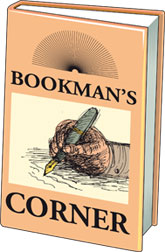
Inspirational book to change your life
Reviewed by Dr. Jonathan McComic M.D.
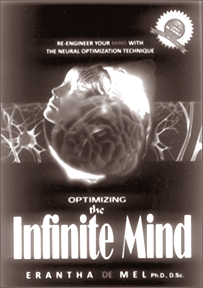
Optimizing the Infinite Mind
Author: Erantha De Mel
Sarasavi Bookshop, Nugegoda
|
Soon after its launch on April 10 in Los Angeles, I had the
opportunity of reading this utterly inspiring book by Prof. Erantha De
Mel - "Optimizing the Infinite Mind". This book very lucidly describes
how you can literally let go of your dysfunctional thoughts, emotions,
beliefs and habits; and the ways of reprogramming your mind utilizing
the Neural Optimization Technique. Neural Optimization explores the
relationship between how we think, and how we optimize our patterns of
behaviour and emotional routines.
It offers an opportunity to alter or re-engineer the way we function
(our in-built neural programs), and it also offers a technology for
creating change. Neural Optimization Technique is a multi-dimensional
process that involves the enhancement of behavioural competence and
flexibility as well as the strategic thinking, and understanding of the
mental and cognitive processes behind behaviour. It provides skills for
the development of states of mind facilitating individual excellence,
and establishes a system of empowering beliefs and presumptions about
what human beings are, what mind-power is, and what the process of
change is all about.
Prof. Erantha De Mel is the founder of the Neural Optimization
Technique. He is an internationally acclaimed Cognitive Neuroscientist
and was the recipient of the Cambridge Blue Book Man of the Year Award
2005 for his contribution to the field of Neuroscience and Cybernetics.
As a practising psychologist and researcher, in both psychology and
parapsychology; he is engaged in extensive research in both fields and
is a scholar with original research into Altered States of Consciousness
and Psycho-Cybernetics.
"Optimizing the Infinity Mind" is for all who wish to expand and
realize their potential. There are thousands of self-help books,
inspirational books, and transformational books written on how to
improve yourself and become efficient and effective. Generally these
books tell us the ways we can change our lives taking successful people
as examples. But very rarely do they tell us how, and the internal
mechanisms involved in the process.
Most of them are very vague, and provide anecdotal accounts, creating
a "like others do we also like to do" mentally. In other words, far too
many self-improvement books look to other external and internal factors
while ignoring the two most important elements - the mind and the brain.
This new book provides the reader with techniques to change and enrich
the internal mind process in order to improve personality, character and
attitude through his/her own efforts and positive mind programming;
thereby creating a lasting change in them. It is a remarkable
self-improvement book with a difference.
The book is written with minimum technical jargon, targeting the
general reader. It comprises three sections namely, the Infinity Mind,
Neural Optimization Technique, and the Optimization Guide. In the
section "Infinite Mind" the author describes the nature and the
potential of mind processes. Also he provides some knowledge of basic
psychology to the reader in order to understand the mind processes. The
second section is an introduction to the Neural Optimization Technique.
It provides the reader with the tools of mind programming.
The section three is an optimization guide addressing issues such as
'Combatting Negative Thought Patterns', 'Re-structuring of Thought
Processes', 'Refining Your Self-Perception', 'Consciousness and Personal
Growth', 'Attitudinal Change', 'Consciousness and Success' to name a
few.Self-improvement begins with self-understanding, knowing your true
potential and of being aware that you are unique.
Improvement can be measured in many ways, in a variety of contexts.
What really does matter is how the individual sees his or her "self",
and what they would perceive as improvement to that "self". The book
provides very important guidelines in self-improvement and the ways of
combating self-crippling beliefs.
"If you try to understand the mind processes and resolve to change
your mind, you can change your life" Prof. De Mel says. "What you
perceive and believe create the actual circumstances in life. By
changing your inner attitudes of mind, you can change the outer aspects
of your life. You may be thinking that success is for a chosen few and
you are not one of them.If this is your thinking, start now to eradicate
that belief from your mind". In pursuit of an objective, a goal, or even
a dream, whether business or personal, it is possible to increase the
likelihood of success by continuously exercising your mind with positive
thinking, self-help, and personal growth. In this new book the author
further goes on to say "Life is an exotic buffer with lots of choices.
But the tragedy is that most people are starving to death. We are
surrounded with joy, with prosperity, with love. Unfortunately, most of
them have no idea of this whatsoever, because they are programmed to
think that such things are beyond their reach. They tend to think that
they've got a raw deal in life. They are programmed with many
self-limiting beliefs. It is vary sad that they dwell in self-created
imaginary prisons and lack a key to access peacefulness and abundance.
We possess an amazing mechanism of power within every one of us that
needs to be activated. We can either look forward to a hopeless end, or
to have endless hope. It's a matter of how we look at life."
One of the most significant strategies that Prof. De Mel offers is
the concept of reprogramming of mind processes. When applied properly
and consistently the techniques described in this book can transform
your whole life. Most of us suffer from low self esteem and a lack self
confidence from time to time. Eventually we believe that
self-improvement is impossible to achieve.These thoughts have been
shaped by past failures and negative experiences. Hopefully we can reach
a point in our life when we are ready for change and are ready to accept
information that will help us unlock our self -improvement power. This
book offers simple and effective techniques to be more focused and
productive in every aspect of your life.
By the way, if you read many inspirational books, you might want to
ask yourself why I should read this book. My humble opinion is that you
only need to read a few good self-help books and this is one of them. I
recommend you to read this book and change your life.
Noteworthy contribution to archaeology
Reviewed by Asiff Hussein
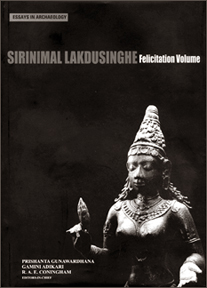
Sirinimal Lakdusinghe Felicitation Volume - Essays in
Archaeology
Eds.Prishanta Gunawardhana, Gamini Adikari & R.A.E.Coningham
Published by Neptune Publications (Pvt) Ltd (2010)
|
This felicitation volume dedicated to renowned scholar Sirinimal
Lakdusinghe is perhaps the greatest contribution in the field of Sri
Lankan archaeology in recent times. The contributions by no less than 45
distinguished scholars in this very exciting field makes some of the
most interesting reading on the subject one can ever come across in a
single volume - and not just for the professional archaeologist, but
just about for anyone interested in the country’s long and eventful
history.
Among the contributions I found particularly interesting was Prof.
Senake Bandaranayake’s fascinating reconstruction of the Lion Palace of
Sigiriya in his well-researched paper ‘Sigiriya: Notes on the
Conjectural Reconstruction of the Palace and the Lion Staircase’.The
paper, which is replete with hypothetical reconstructions of the palace
complex and the colossal Sphinx-like lion figure that gave it its name
of Sigiriya or ‘Lion Rock’ arrives at some interesting conclusions as to
how the structure would have looked like in its heyday.
Of particular interest is the so-called Sunset Pavilion perched at
the southern extremity of the upper palace where the ridge of the zone
is at its narrowest, thus affording it a nearly 360 degree view of the
horizon, making it the ideal spot to view the sunset over the famous
water gardens of Sigiriya.
Another revealing contribution “Horton Plains as a World Heritage
Site” by Dr. T. R. Premathilake attempts to show that the Horton Plains
of Central Sri Lanka was the home of an incipient prehistoric farming
community that engaged in rice cultivation several millennia ago as
indicated by the presence of phytoliths (siliceous micro-fossils) of
Oryza Sp (cultivated rice).
This is quite a revelation considering the hitherto held belief that
rice cultivation was introduced by Indo-Aryan settlers from India only
around the 5th century B.C.
It also provides a basis for the country to stake a claim as one of
the earliest centres of human civilization where agriculture had been
developed independently to a high level as far back as 15,000 to 13,000
years ago by hunter-foragers who had somehow acquired the technique and
practices to convert wild plants into domestic ones. This compares
favourably with other ancient sites of cereal cultivation such as Xian
Rendong in China which goes back to 14,000 years ago and other sites
such as Abu Hureyra in the Euphrates and Ghaba Valley in Syria going
back to 13,000 years ago.
Nimal De Silva’s contribution “Magama, the ancient capital of Ruhuna”
reveals some interesting facets in the urban planning of the ancient
city of Magama which served as the capital of the southern Ruhuna
kingdom from the 3rd century B.C. for a period of nearly fourteen
hundred years.
Originally a large village as evident from its name of Maha-gama or
‘Great Village’, its development was greatly facilitated by its
proximity to the Kirindi Oya, so much so that it had within a short
period developed into a substantial metropolis with trade links with
India and the Roman Empire as evident from archaeological findings such
as Indian Red Polished Ware and Roman Roulette Ware.
Melathi Saldin’s “Megalithic burials and Anuradhapura” discusses the
reasons for the absence of megalithic cist burials in the immediate
vicinity of the city of Anuradhapura which is conspicuous for the
absence of megalithic burial sites found in many other parts of the
island, particularly in the North Central plains.
In her thought-provoking paper, Saldin seeks to reassess the commonly
accepted hypothesis that the megalithic burials belonged to a group of
pastoral nomads on the periphery of those who occupied Anuradhapura, and
concludes that the lack of field work done in this regard could be one
of the reasons for their non-discovery, though she does not rule out the
effects of city expansion from early times up to the present day and the
possible destruction of such burial sites due to agricultural and other
human activities which is not untenable given that many of the Dry Zone
cist burials are located in the fertile Reddish Brown Earth Zone of the
island.W.H. Wijayapala’s Pre-historic bone artifacts from Sri Lanka
gives us an insight into some of the earliest instances of animal bones
used for manufacturing artifacts where we find a tendency to select the
bones of smaller animals for fashioning such artifacts which were
probably used to hunt small animals.
This is lent support by an analysis of faunal remains gathered from
cave sites such as Alulena and Belilena where the majority of remains
were of smaller animals such as hare, monkey and porcupine.
Further, as borne out by the remains of fish bones from Kitulgala and
Batadombalena, fishing was evidently practised by pre-historic man in
Sri Lanka, and it is suggested that shanks of jungle fowl with the spurs
on them were possibly used for this purpose.
Another interesting paper by Senarath Dissanayake on the Fertility
Cult that existed in Sri Lanka before the Advent of Buddhism seeks to
connect the mare-faced Yakkhini named Valavamukhi who figures in the
Mahavamsa as an ally of King Pandukabhaya with Parvati, particularly in
her aspect as Durga on the basis of certain similarities such as
connection with mountains and warfare.
Among other notable contributions one would find Nanda
Wickramasinghe’s Technique of Sigirya Paintings, Senarath
Wickramasinghe’s Study of a hoard of punch-marked coins found at
Mirigama and Jayampath Senanayake and Roshani Rammungoda’s Petroglyphs
of Urakanda- Sri Lanka.
This volume is no doubt the most noteworthy contribution to modern
Sri Lankan archaeology and is a must-read for all those who are
interested in this fascinating subject.
User-friendly guide to short stories
Reviewed by R.S. Karunaratne
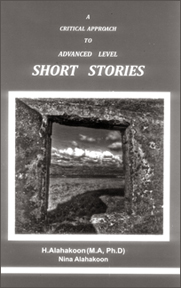
A Critical Approach to Advanced Level Short Stories
Authors: H. Alahakoon and Nina Alahakoon
A Polytechnic International Publication
|
Most of us are aware of the literary form 'short story' which is
usually defined as a short fictional prose narrative, often involving a
single connected episode. Way back in the early 19th century the
American writer Edgar Allan Poe analysing the aesthetic properties of a
short story said that the unity of a single episode is the most
important element. Although real life incidents are rarely unified, a
short story needs to have unity. Despite the fact that short stories are
basically fiction, they must appear to be true to the reader.
All short stories should have a plot, characters, setting, point of
view, style, and theme. The writer will make use of his language to set
all these elements in motion to create a kind of mystery or magic of
real life. The range and quality of the short stories will vary from
writer to writer. Most short stories published in newspapers may not
have the depth found in those penned by authors such as D.H. Lawrence,
Katherine Mansfield or Nathaniel Hawthorne. A good short story is an
illusion of reality created by a writer for the imagination of the
reader.
With the change of the Advanced Level syllabus, both students and
teachers may find it difficult to understand and comment on the new
selection of short stories. Therefore, 'A Critical Approach to Advanced
Level Short Stories' written by Dr. H. Alahakoon and Nina Alahakoon will
serve as a useful guide.
The authors have critically analysed Chitra Fernando's 'Action and
Reaction,' Alagu Subramanium's 'Profesisonal Mourners', Ernest
Hemingway's 'Hills like white elephants,' James Joyce's 'The Boarding
House,' Saki's 'The Open Window,' and Jumpa Lahiris' 'The temporary
matter.'
The novel approach adopted by the authors is praiseworthy. For
instance, while commenting on Chitra Fernando's 'Action and Reaction,'
the authors have explained the Buddhist concept of Karma in detail. The
appreciation and the comment that follow will help anyone to understand
the short story without much difficulty.
All the short stories have been dealt with in the same way.
Most of the guide books produced locally are full of typographical
and factual errors. Fortunately the book appears to have been edited and
proofread by a professional.
Therefore, it can be recommended as a useful guide to short stories
prescribed for the GCE (Advanced Level) examination.
First Sinhala book on road building
Reviewed by Eng Kamal Weeratunga
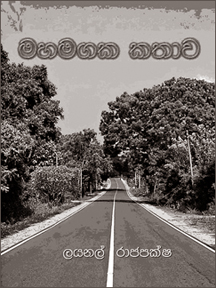
Publisher: Chandana
Kulatunga,
‘Mahamangaka Kathawa’
Author: Lionel Rajapakse
|
Eng Lionel Rajapakse, retired Director, Road Development Authority,
has written 'Mahamangaka Kathawa' (The Story of a Highway), a book about
the history, and planning, design, construction, maintenance and
management of roads in Sri Lanka. As far as I am aware, this is probably
the first book on the subject written in Sinhalese; so, it is a
pioneering work.
'Mahamangaka Kathawa' explains some technical aspects behind road
building in simple language without going into too much technical
details. That way, it is reaching out to not just those in the industry
but a wider audience including those who may have a general interest in
the history of infrastructure development in Sri Lanka.
There is a fine line between writing for a technical audience as
opposed to a general audience, which is not always easy to maintain. Eng
Rajapakse seems to have maintained that fine balance throughout his book
making his book potentially interesting reading material for both
technical and general audiences.
In his book, Eng Rajapakse has tried to touch on all aspects of road
building so that it helps one to understand that road building is not
just about pouring bitumen on a layer of crushed rock. After presenting
a brief history of road building, he introduces the reader to the
systematic approach taken in, Highway Planning and Design, Construction
and Materials, Traffic Studies, Bridge Design and Construction, Road
Administration, Maintenance and Legal Aspects, Economic and
Environmental Issues, Road Safety and Expressways and Technology.
With the whole gamut of road building from planning through to
construction and maintenance of a road being covered in the book, it
could potentially serve as a useful source of reference for those
studying Highway Engineering in Sinhala medium at Technical Colleges.
The most interesting aspect of Eng Rajapakse's book to me is the
blending of historical aspects of road building with the current
engineering point of view. Not many engineers have the knowledge or the
skills to do so. In 'Mahamangaka Kathawa', amongst other historical
details about road building in Sri Lanka, you can also read about the
opening ceremony of the original Katugastota Bridge across Mahaweli
River built between 1858 -60, which included a dinner and a ballroom
dance on the bridge deck with Sir Henry Ward, the then Governor of Sri
Lanka as the chief guest.
While Eng Rajapakse has covered many aspects of road building in his
book, I would have liked to see a bit more information on traffic
operations in the book, particularly about managing congestion,
minimising travel times and improving travel time reliability, although
he has briefly touched on some of these aspects under 'Expressways and
Technology'.
Sri Lanka has a matured highway and arterial road network; however,
it is probably not an overstatement to say that it operates in chaotic
conditions most of the time. Focusing on improving the operation of this
existing highway and arterial road network is at least as equally
important, if not more, as construction and maintenance of roads. I
think Eng Rajapakse has made a commendable effort in making a difficult
but important first step in delivering a book related to Highway
Engineering in Sinhala. I wish him good health, courage and energy to
continue to do all the good work he has been doing throughout his life,
over many years to come.
Pujya Pallewela Saddhathissa Nahimi Dharma Desana
| Ven Borelle Kovida Thera's 'Pujya Pallewala Saddhathissa Nahimi
Dharma Desana' will be launched at Dharmasrama Vihara, Baseline Road,
Colombo 10 on May 2 at 3 pm.
Most Venerable Davuldena Gnanissara Mahanayake of the Amarapura Maha
Sangha Sabha, Ven. Bellana Gnanawimala Mahanayake of Kotte Kalyani
Dharma Maha Sangha Sabha and Ven. Balangoda Sobhitha, principal
Vidyodaya Pirivena, will preside over the launching ceremony. Ven.
Kotugoda Dhammawasa Mahanayake of Amarapura Maha Sangha Sabha and Ven.
Maduluwawe Sobhitha Viharadhipathi, Naga Vihare, Kotte will deliver
anusasanas. Ven. Pitigala Wijitha Senior lecturer of Pali and Buddhist
University will direct the proceedings.
'Pujya Pallewela Saddhatissa Nahimi Dharma Desana' is a Dayawansa
Jayakody publication. |
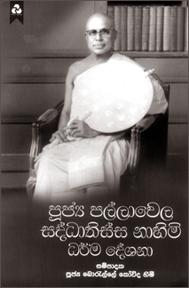 |
|
New books on the shelf:
Pavura
Samadara Chandani Danthanarayana's Sinhala novel 'Pavura' was
launched recently as a Sooriya publication. The story revolves around a
family who lived in the Galle Fort during the World War II. Her first
novel 'Sansara Bandhana' was published in 2007. |
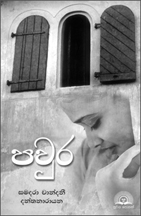 |
|

